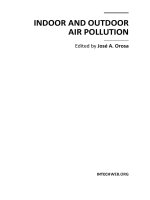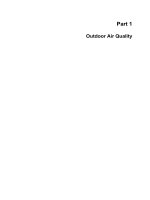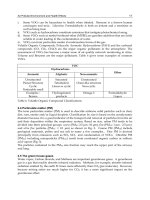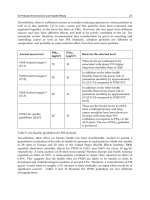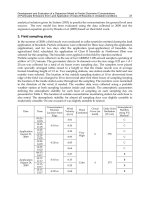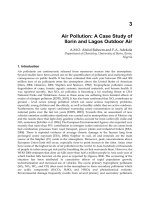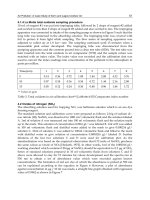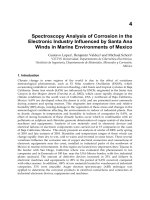Indoor and Outdoor Air Pollution Part 8 pot
Bạn đang xem bản rút gọn của tài liệu. Xem và tải ngay bản đầy đủ của tài liệu tại đây (283.92 KB, 10 trang )
4
Spectroscopy Analysis of Corrosion in the
Electronic Industry Influenced by Santa Ana
Winds in Marine Environments of Mexico
Gustavo Lopez
1
, Benjamin Valdez
2
and Michael Schorr
2
1
CETYS Universidad, Departamento de Cibernética-Electrónica,
2
Instituto de Ingeniería, Departamento de Materiales, Minerales y Corrosión,
México
1. Introduction
Climate change in some regions of the world is due to the effect of variations
meteorological phenomenon, such as El Niño southern Oscillation (ENOS), which
occasioning rainfalls in winter and even flooding, cold fronts and tropical cyclones in Baja
California. Santa Ana winds (SAW) are influenced by ENOS, originated in the Santa Ana
Canyon in the Mojave desert (Traviña et al, 2002), which cause rapidly changes in the
climate conditions in the south west of California, USA y northwest of Baja California,
Mexico. SAW are developed when the desert is cold, and are presented most commonly
during autumn and spring seasons. This originates fast temperature rises and relative
humidity (RH) drops, causing damage in the vegetation of these zones and changes in the
meteorological conditions affecting the environments in indoor of industrial plants. Due
to drastic changes in temperature and humidity in indoors of companies by SAW, an
effect of strong transitions of these climatic factors occur which in combination with air
pollutants as sulphurs and chlorides generate deterioration of copper metals of electronic
machines and equipments. Analysis of raw materials used in electronic devices and
electrical failures of electronic components were carried out in 15 companies in the coast
of Baja California, Mexico. This study presents an analysis of winter of 2009, early spring
of 2010 and late autumn of 2010. Humidity and temperature ranges of these winds can
change rapidly from dry to wet, cold to warm and reverted in some hours. These several
variations influence the corrosion rate of copper electrical connectors and connections of
electronic equipments near the coast, installed in industrial parks of the northwest of
Mexico in marine environments. In this region are located two important cities: Tijuana in
the border with San Diego, California where was evaluated this phenomenon in ten
companies and in Ensenada at 100 km. near the USA-Mexico border, with five industrial
plants analyzed. The amount of defective devices increased in 25% and failures in
electronic machines and equipments in 28% in the period of SAW occurred, compared
with other seasons. In addition, 100% of raw materials located in warehouses of industrial
companies, 33% were unusable. Auger electron spectroscopy (AES) technique was
applied to determine the corrosion products in electrical connections and connectors of
industrial electronic devices, equipments and machines.
Indoor and Outdoor Air Pollution
62
1.1 Electronics industry
The electronics industry has grown over the past fifty years, contributing to the economy.
Particularly in the Baja California State located in the northwest of Mexico, these companies
have prospered in the industrial parks of Tijuana and Ensenada, on the Pacific Ocean
considered as a marine region. In this environment, during winter and summer, the climate
main factors at indoor conditions: humidity and temperature, affect electronic devices and
industrial machines (Lopez et al, 2007). The change of climate in indoor of electronic plants
is due to the variation of humidity, temperature, solar radiation, concentration of air
pollutants such as CO, SO
2
, H
2
S, NO
X
, O
3
and solid particles Pm
2.5
and Pm
10
. The air
pollutants and solid particles are monitored by Environmental Monitoring Stations (EMS) in
Tijuana. While, SO
X
and Cl
-
were determined in Ensenada by Sulfatation Plates Technique
(SPT) and Wet Candle Method (WCM), and metallic probes and in both cities were analyzed
by AES. Electronic equipments installed inside the plants are fitted with copper components
since they exhibit electrical and thermal conductivity. With the deterioration of copper, the
equipment functionality decreases, generating failures and economic losses. This equipment
is exposed to a wide range of indoor aggressive environments causing corrosion damage.
1.2 Atmospheric pollution
Gaseous and solid airborne pollutants comprises small dust particles hydrogen sulfide
(H
2
S), sulfur dioxide (SO
2
), chloride ions (Cl
-
) and nitrogen oxides (NO
X
) which are capable
of penetrating into indoor areas of the industrial plants through inlets of air filtering
systems. These pollutants generate aggressive indoor environments in combination with
humidity and temperature, producing corrosion damage of metallic components of
electronic equipment. In spite of the existing corrosion prevention and protection system as
well as application of electronic industry standards, corrosion control is not easy in specific
climatic regions, especially in arid and marine regions (Dillon, 2000). Arid zones are typical,
with RH ranging from 30% to 90% in summer with temperatures higher than 40°C and
winter temperatures lower than 5°C. In marine environments, the RH is around 20% to 80%
and temperatures in summer arises 35°C and diminishing to 3°C in winter. These factors,
promoted by anthropogenic and natural activities facilitate the corrosion of the copper
components (Valdez et al, 2006). The corrosion of copper specimens was evaluated by the
gravimetric method; it was correlated with the minimum, average and maximum RH and
outdoor temperature values in different seasonal periods, which affect the indoor climate
plants. The efficiency of the electrical behavior of copper components in electronic devices is
a function of the amount of humidity and pollutants present in the indoor environment
(Veleva et al, 2008).
1.3 SAW and their effect on climate factors
A weather phenomenon in the region of California, USA and Baja California, Mexico, is
SAW, which appears in finals of autumn and early of winter and spring (Traviña et al, 2002).
This leads sometimes drastic changes in humidity and outdoor temperature affecting the
indoor environments of industrial plants, originating in the manufacturing processes
failures in electronic devices and equipments, causing low yielding. Moisture is the most
important climatic factor that has a negative effect of this phenomenon, decreasing in certain
periods of this meteorological phenomenon from values of 80% to 30%. SAW pass through
Spectroscopy Analysis of Corrosion in the Electronic Industry
Influenced by Santa Ana Winds in Marine Environments of Mexico
63
the mountain and sometimes reach the hurricane force. The combination of wind, heat, and
dryness generates dry vegetation and thus is an explosive fuel for fires acquaintances and
often devastates the region. Though winds are often of a destructive nature, may have some
positive results too. They can make the cold water rises from the ocean bottom to top,
dragging many nutrients that ultimately benefit the fishery. As winds blow over the ocean,
the temperatures of the sea surface fall around 4 ° C (7 °F), indicating an upwelling of deep
ocean water. The evaporation process originated by SAW generates increases of
temperatures by about in 5 º C. These variations modify the physicochemical properties of
metallic materials and occur in some times a partial deterioration and in a few times after
the beginning of SAW originates the corrosion in metallic materials as copper. This
concerned to companies for the economic losses of defective electronic products and
promotes rapidly the corrosion process on connectors and electrical connections and thus
causing electrical failures, malfunctioning in electronic equipment and in some cases stops
the manufacturing line. This causes warm climates, causing deterioration in some metallic
materials used in the electronic connectors and connections such as copper. This decrease
the quality of the articles manufactured in this region and generates economic losses (Lopez
et al, 2007). When variations of humidity are very drastic, occurs several variations of
temperature and therefore the electronic equipments and devices suffer changes in their
functionality. To measure humidity ranges, is necessary install sensors in indoor of
industrial plants be in contact with environments This study in this region is important by
the influence of pressure difference of air mass between the mountains of California, United
States and marine areas of northwestern of Mexico country, where companies are located in
these the cities: Ensenada (300,000 people) and Tijuana (2,000, 000 people) (CONAPO, 2010).
An analysis of wind direction and speed was made in the seasons studied to correlate this
climate factors with the electrical failures of electronic equipments (Table 1).
Month Wind Direction (º) Wind Speed, m / s
Ensenada Tijuana Ensenada Tijuana
January 66 72 14 11
February 69 70 16 13
March 67 69 14 12
April 61 63 18 14
May 223 228 10 7
June 228 234 11 9
July 192 198 14 10
August 195 201 13 11
September 206 211 10 8
October 204 207 11 8
November 63 69 8 6
December 67 74 9 6
Table 1. Analysis of wind in Ensenada and Tijuana (2010)
Indoor and Outdoor Air Pollution
64
Wind direction from January to April and November to December was from southwest to
northeast (60º to 70º), and in May to October, winds were reverted to the same direction
(180º to 240º) and wind speed was at velocities less of 20 m/s. In the months that SAW is
presented, RH decreased from 95% to 40% and temperature increased from 35 °C to 20 °C
very fast in some hours in indoor of industrial plants.
1.4 Climate factors vs. electrical failures
Electronic equipment and machines of industrial plants consist of printed circuit boards,
also called e-cards. The lifetime of these electronic components is according to the type of
material, operation and exposition to environment. In some occasions, the durability
decreases by the exposition to air pollutants and climatic factors, mainly drastic variations of
humidity and temperature (Veleva et al, 2008, Lopez B.G. et al., 2010). Engineering design,
manufacturing methods wrongs and inadequate mechanical movements generate improper
installations. E-cards are constituted of a lot of electronic devices and are installed according
to their operation, with sections separated with insulators to avoid electrical connections
between undesirable zones (analog or digital signals), power (high and low), speed (high
and low) and types of printed boards. There are a variety of electronic components, which
are classified according to wave (sine, triangular, square or linear). In this study, an analysis
of climate factors and electrical failures of electronic equipments installed in indoor of
industrial plants of these marine zones was made (Figure 1).
Fig. 1. Correlation of climate factors with electrical failures in industrial plants (2010).
In the absence of SAW, values of RH were in the range of 80% to 90% and temperatures
variety from around 15 ºC to 30 ºC and electrical failures by an average of 20% at month.
Spectroscopy Analysis of Corrosion in the Electronic Industry
Influenced by Santa Ana Winds in Marine Environments of Mexico
65
When SAW were presented, RH diminishes to around of 30% and temperatures increases by
5 ºC and occurring electrical failures that are increased around 50%.
2. Materials and methods
Copper is used in electronic devices and equipments for the manufacturing of electrical
connections and connectors, t for its good electrical and thermal conductivity. Nevertheless,
is very susceptible to corrosion at the indoor polluted conditions.
2.1 Climate factors
Moisture content for interior environments modifies the physicochemical properties of
metallic materials and increases strongly their micro and nano deterioration by the variation
of air moist to dry, causing warm climates very quickly (Zlatev et al, 2009, Cole, 2004).
Climate is composed of several parameters, where the relative humidity and temperature
are the most important in the damage to these materials (ASHRAE, 1999), expressed with
their measurements units and instruments (Table 2). Scientists that analyze deterioration of
materials and climatic conditions in indoor of industrial plants, consider that a bad
operation of industrial equipments is due to the presence of drastic changes in humidity and
temperature in certain times of the year (Lopez, 2008), as is expressed in ISO 9223 (ISO9223,
1992). Experts in industrial productivity and quality manufacturing consider that in these
region defective products and electrical failures in electronic equipment of industrial plants
are presented and create a tense in managers in the companies because causes great
economic losses.
Factors
Measuring
Instrument
Unit
Humidity Hygrometer %
Temperature Thermometer ◦ C
Atmospheric pressure Barometer mmHg
Solar radiation Pyranometer W / m2
Pluvial Precipitation Rain gauge mm
Wind direction Wind vane ◦ Grade
Wind speed Anemometer m/s
Table 2. Climatic factors and their measurement
2.2 Corrosion testing
Copper specimens for corrosion testing were exposed in at indoor conditions of electronics
plants for a period of two years in Mexicali and in Ensenada. The specimens corrosion was
evaluated according to the ASTM standards G 1, G 4, G 31 (ASTM, 2000), and correlated
with the minimum, average and maximum outdoor RH, TOW and temperature parameters
(ISO 11844-1, 2006). The electronic plants in Tijuana where they are located in industrial
parks while in Ensenada, plants are located at distances ranged between 1 km to 10 from the
sea shore. Rectangular specimens with dimensions of 2.5 cm. x 1 cm. x 0.5 cm. were cleaned
by immersion in an isopropyl alcohol ultrasound bath for 15 minutes. Immediately after
cleaning the copper specimens were placed in sealed plastic bags, ready to be installed in
Indoor and Outdoor Air Pollution
66
the test indoor sites. After each exposure period the specimens were removed, cleaned and
weighed to obtain the weight loss and to calculate the corrosion rates (CR) (ISO 11844, 2005).
The corrosion products morphology was examined with an optical microscope. The most
active gases are hydrogen sulfide (H
2
S) and SO
X
. H
2
S is a corrosive and toxic pollutant
which originates from municipal sewage (Moncmanova, 2007; Lopez B. et al, 2010).
2.3 Numerical analysis
A mathematical correlation was made in MatLab software (Duncan et al, 2005) to determine
the corrosivity levels (CL) in indoors of electronics industry in Mexicali an Ensenada, With
this analysis find out the deterioration grade (DG) of metallic probes of copper, correlating
the climate factors (humidity and temperature), airs pollutants (CO, NO
2
, O
3
and SO
2
), from
outdoor sources that penetrate by inlets or air-conditioning systems, to indoors of industrial
plants and corrosion rate (CR).
2.4 Characterization of atmospheric corrosion in industrial plants
Corrosion in indoor atmospheres is influenced by external climatic conditions generating
the time of wetness (TOW). TOW is an important factor in the generation of corrosion in
electrical connectors and connections of electronic devices, was obtained with variations of
RH and temperature, showing high rates in some periods of winter and summer by the
SAW phenomena. This is an important factor to determine the type of corrosion that occurs
in metals and the levels which increases the corrosion rate (CR). In this process, cells formed
by corrosion process, originate galvanic corrosion, for example in the binding of platinum
and zinc with 0.2 volts, which are capable of cause an electrical failure in electronic devices
and equipments. The origin of corrosion in indoors of industrial plants is due to climatic
factors and the concentration of air pollutants. In winter, corrosion is generated uniformly
by wetting film formed on metals, and in summer in the materials analyzed appears small
tarnishings, as a result of some air pollutants and drops adhered to metals surface. The
TOW obtained of variations of RH and temperatures with values over of 80% and 0 ° C, that
is characteristic of three cities evaluated, is an important factor in the origination if
corrosion in metals. All regions analyzed, showed corrosivity levels (minimum and
maximum), that are a cause of generation of aggressive environments, and the corrosion
process. The period of copper exposure, appears small tarnishing in some areas of metallic
probes, which caused pitting and uniform corrosion (Lopez , 2008).
2.5 Spectroscopy examination techniques
The examination technique with the Auger Electron Spectroscopy (AES) was used to
determine the air pollutants that reacted with the copper surface of metallic probes and the
morphology with the Auger map (Yves Van, 2008). Electrons flows through the instrument
to generate low energy showed the topography of metals tested. Once it determines the
chemical composition of elements and compounds in the specimens, and observed the air
pollutants deposited on metals and know that they affect in the generation of the corrosion
process. With this technique we knew in detail, quickly and with precision, the structural
form and location of corrosion, which will determine the type of corrosion and know the
techniques protection for the metals analyzed (Asami et al, 1997, Briggs, 1990)). The
specimens were exposed in indoor of industrial plants with values of relative humidity and
temperature over 90% and 20 ºC in winter and 80% and 15 ºC in summer, and removed for
Spectroscopy Analysis of Corrosion in the Electronic Industry
Influenced by Santa Ana Winds in Marine Environments of Mexico
67
one, three and six months and analyzed with EDX and AES spectroscopy to identify the
corrosion products formed on the copper surface. Metallic probes were exposed in periods
of 1, 3 and 6 months showed tarnish in some regions, but from the seventh month to the
final period of study, in the specimens appear corrosion on the full surface of copper, and
corrosion rate decreases by the formation of a copper oxide film, serving as a protective
layer. The analysis obtained by EDX and Auger S2 models was made with Ranger and
ESCA / SAM 560 of Perkin Elmer. The Auger spectra showed the chemical composition and
use the sputtering method to clean the copper surface, bombarding with Ar+ ion beam with
energy of 5keV and current density of 0.3 uA / cm
3
, to remove the CO2 pollution of the
environment.
3. Results
The rapid transitions of temperature and humidity in indoor of companies caused by SAW
and generate aggressive environments in combination with air pollutants generated in
indoor of industrial plants and stays longer periods of time suspended in the air and
causing more damaging in electronic equipments.
3.1 Deterioration of metals used in industrial plants
Ranges of RH and temperature were higher than 70% and 35ºC during the year in Tijuana
and with a minimum of 20% and 30ºC in the periods of heat winds (early winter and spring)
and maximum of 80% and 10ºC in the rest of the year in Ensenada area. Levels of humidity
and temperature bigger 70% and 30 °C accelerated the rate of corrosion. In summer the
corrosion rate was higher after one year in Tijuana and also was in Ensenada. For
temperatures in the range from 25 ºC to 35 ºC, and RH level of 30% to 70%, the corrosion
rate was very high. Furthermore, in winter, at temperatures around 15 ºC to 25 ºC and RH
levels from 35% to 75%, water condensates on the metal surface and the copper corrosion
rates increases very fast. Variations of RH in the range from 30% to 80% and temperatures
from 0 ºC to 35 ºC, and concentrations of air pollutants such as sulfides and chlorides in this
marine environments, exceeding the permitted levels for air quality standards, are also an
important condition that favors corrosion. Corrosion processes can be accelerated in
polluted atmospheres in the presence of variations of humidity and temperature. The origin
of corrosion in metallic materials such as copper, used inside the electronics industry is due
to the action of climatic factors and effect of air pollutants. In the autumn and winter,
corrosion is generated by a film formed uniformly on metals, and in spring in these
materials are pitting as a result of some small drops that adhere to certain areas of the metal
surface (Lopez et al, 2010). This is partly of the variations of humidity and temperatures that
is typical of this city during certain seasons of the year. Is necessary monitoring and control
principally the relative humidity and hold the adequate range to permit the good
functionality of the equipments and products to avoid defective products and electrical and
mechanical failures of electronic equipments during the presence of SAW. The values of
relative humidity and temperature were lower 40% and 20 ºC during the year. At beginning
of spring season, the corrosion rate increases in the range 15 ºC to 30 ºC, with relative
humidity level of 25% to 40%. Furthermore, in autumn and winter the several changes of
RH and temperature, water condensates on the metal surface and the copper corrosion rates
increases. At temperatures of 17 ºC to 25 ºC, with the variations drastically of RH levels,
Indoor and Outdoor Air Pollution
68
corrosion rate was high too (Table 2). The emissions of vehicles are an important factor
source of air pollutants, are cars that is important in the marine zone and emissions of
thermo electrical operations where the electricity is generated to this. The air pollutants
affect on the metals and the corrosion rate depend on the pollutant concentration in air and
their corrosion resistance in the region. The Cu
2
O layer can be gradually dissolved in the
acidic electrolyte formed in the presence of SO
2
and Cl
-
. A computer based model of
atmospheric corrosion has been used to simulate copper exposed to room temperature to
200 ppb SO
2
, in combination with either NO
2
or O
3
at different concentrations.
Climate factors
Sulphur oxide (SO
2
)
Nitrogen oxides (NO
X
)
Ozone (O
3
)
RH
a
T
b
C
c
CR
d
RH
a
T
b
C
c
CR
d
RH
a
T
b
C
c
CR
d
Spring
Max
Min
74.5
22.7
22.3
10.2
0.21
0.18
225
17
79.3
29.6
29.5
11.7
0.42
0.28
208
109
69.7
21.5
24.3
12.5
0.29
0.12
193
145
Autumn
Max
Min
86.4
26.4
28.6
19.4
0.27
0.16
289
174
73.9
25.4
31.7
12.7
0.44
0.19
265
168
74.9
18.7
29.5
14.8
0.52
0.18
268
203
Winter
Max
Min
69.2
19.3
22.6
13.3
0.48
0.32
324
152
85.1
28.6
25.7
14.8
0.56
0.29
231
188
79.9
26.4
28.9
12.8
0.67
0.23
273
165
[a] RH. Relative Humidity (%) [b] T. Temperature (ºC)
[c] C. Concentration Level of Air Pollutant (ppm)
[d] CR- Corrosion rate (mg/m
2
.year).; Source. Environmental Monitoring Stations.
Table 3. Effect of RH, temperature and air pollutants on the corrosion rate of copper in
Tijuana.
3.2 Corrosivity levels analysis
Corrosivity levels (CL) represents the degradation grade (DG) of materials in according to
the correlation of relative humidity, temperature and air pollutants concentration mentioned
above. CR was calculated from the atmospheric pollution in indoor of electronics industry,
indicating which air pollutants with major grade of damage to copper was dioxide sulphide
(SO
2
) and the ion chlorides (Cl
-
) in both cities.
In both cities, RH was correlated with the major CR was 30% to 50% with temperatures of
25˚C to 40˚C. In summer CR was different than in winter, and in both environments (Figures
2 and 3). The electronics equipment corrodes at high humidity levels. Air pollutants such as
CO, NO
X
and sulfides penetrate through defects of the air conditioning systems. Corrosion
phenomena affect connections of electronic equipment and other electronics components
protected with plastic or metallic materials (Sankara et al, 2007). Atmospheric corrosion is an
electrochemical phenomenon that occurs in the wet film formed on metal surfaces by
climatic factors in Tijuana was presented pitting corrosion and in Ensenada was presented
Spectroscopy Analysis of Corrosion in the Electronic Industry
Influenced by Santa Ana Winds in Marine Environments of Mexico
69
Fig. 2. CL of copper after one year of exposition in Ensenada (2010).
Fig. 3. CL of copper alter one year of exposition in Tijuana (2010).
the uniform corrosion. This behavior of corrosion was showed in the first month of the
period of evaluation. Figure 2 shows the CL of indoors of electronics industry in Ensenada,
indicating the level1, the major aggressive environment and levels 4 the high aggressiveness
grade (AG) which generate high DG of this type of materials. Some sections of the graph,
represents the different grades of AG, with high areas of level 1 and 2 and levels 3 and 4
Indoor and Outdoor Air Pollution
70
exists in less percentage. This can generate failures in the electronic devices and equipments
in indoor of industrial plants. RH and temperature ranges were from 30% to 75% and 20 ° C
to 35° C with CR from 30 μg/m
2
.year to 100 μg/m
2
.year. The same was occurred in Tijuana
city that is showed in figure 3. Evaluation of CL in Tijuana indicate that same range of levels
presented in Ensenada, with RH and temperatures from 40% a 75% and 20 ° C to 35 ° C,
with CR from 10 to 160 μg/m
2
.year. Microcircuits, connectors and electrical contacts used in
the electronics industry, are susceptible to atmospheric corrosion, which occurs in indoor
plants in the industrial plants in Tijuana and Ensenada. Corrosion rates obtained in semi-
arid testing points (Tijuana) is higher than those from the marine environments (Ensenada),
since in the arid zone the principal air pollutant is H
2
S and in the marine zones,
predominate the Cl
-
ion as the major corrosive. A comparative analysis, after six months of
exposure of copper specimens shows higher levels of deterioration by corrosion in Tijuana
regarding to the Ensenada results.
3.3 AES examination
AES analyses were carried out to determine the corrosion products formed in the copper
surface. Figure 1a show scanning electron micrograph (SEM) images of areas selected for AES
analysis covered by the principal corrosion products which are rich in chlorides and sulphides
in metallic specimens evaluated in both cities. The Auger map process was performed to
analyze punctual zones, indicating the presence of Cl- and S as the main corrosive ions present
in the copper corrosion products. The Auger spectra of Cu specimens was generated using a
5keV electron beam (Clark et al ,2006), which shows an analysis the chemical composition of
the thin films formed in the Cu surface in Ensenada (Fig 2) and in Tijuana (Fig 3). The AES
spectra of copper specimens installed in industrial plants in both cities show the surface
analysis of three points evaluated in different zones of the metallic probes. The peaks of Cu
appear between 905 and 915 eV, finding the chlorides and sulphides. In figure 2, the spectra
reveals the presence of carbon and oxygen, chlorides and sulphides, with variable
concentration in the chemical composition in the three regions analyzed, where the principal
pollutant was Cl- ion. Figure 3 corresponds to the specimens installed in companies in Tijuana
city. In the regions of copper surface analyzed were observed different concentrations of
sulfur, carbon and oxygen, while the main air pollutant detected was H
2
S. The atomic
concentration (%) of the chemical elements in each spectrum was organized in Table 4. To
draw this figures a program: sigma plot was applied. The spatial resolution of this technique is
around 100 nm and a 1 nm depth resolution (Swart, 2010).
The metallic samples of 1, 3 and 6 months to the metals analyzed show localized corrosion
with small spots and from the seventh month to the one year the spots were observed larger,
being more concentrated corroded areas and generated uniform corrosion. Auger spectra
show an analysis of the chemical composition and a microphotograph on the metals surface
(Figure 4) and with the sputtering [14, 15] was observed the corrosion and passivity process
that generate the copper oxide film to reduce corrosion. Air pollutants added to copper
surface form thin layers in according to the adhesion grade, in some with more chloride ions
(light color) and other with less concentration of sulphur (dark color) for the marine
environment in Ensenada (Figure 4a) and elements with carbon oxide of the environment by
the sensibility of the Auger equipments was showed in the spectra (Figure 4b). In the
analysis of Auger spectra in Tijuana that is an arid environment, the major air pollutant that
reacts with copper surface was the sulphur, represented by the Auger map (Figure 5a) with


